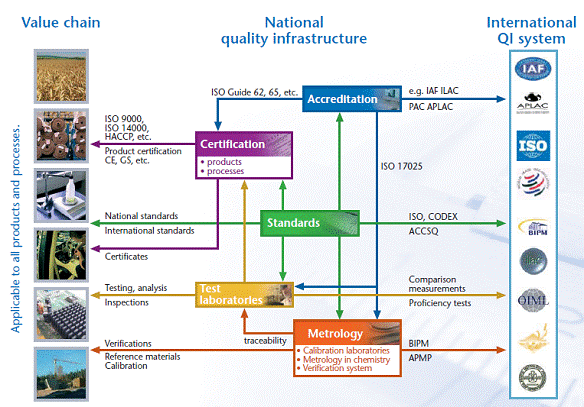
The World Trade Organization (WTO) is the international organization dealing with the global rules of trade between nations. WTO function is to ensure that trade between the different nations and countries flows freely as possible without any barriers.

The three technical partners, ISO (International Organization for Standardization) - together with IEC (International Electro technical Commission) and ITU (International Telecommunication Union) - has built a technical partnership with WTO enabling WTO to impose technical barriers to trade(TBT) by eliminating tariff barriers on the trade. The political agreements reached within the framework of WTO require infrastructure of technical agreements. Now ISO, IEC and ITU are the three principal organizations in international standardization. These three organizations have the complementary scopes, the framework, the expertise and the experience to provide this technical support which is called “Quality Infrastructure or Technical Infrastructure” which leads towards global market growth.
(Fig (Source PTB Germany) shows the National Quality Infrastructure link with the International Quality Infrastructure and its affect and link in improving the quality of national products and processes).
The World Trade Organization (WTO) after its existing in January 1995, on the one side eliminates tariff barriers on trade but on the other side imposes technical barriers to trade in shape of TBT and SPS agreements. These both agreements of WTO i.e., TBT and SPS Agreements rely upon the efficient functioning of the underlying technical infrastructure to support the system and the exchange of products across the borders worldwide. Therefore, Metrology, Standards, Testing and Quality through recognized accreditation system are thus essential elements of technical infrastructures. Now, a days a commonly term Metrology, Standards, Testing and Quality (MSTQ) or Standards, Quality, Accreditation and Metrology (SQAM) is called “Quality Infrastructure”.
In the “Quality Infrastructure” system, accreditation plays a very vital role. Accreditation is the apex body because it accredits the certification bodies for different standards, accredits the testing and metrology (calibration) laboratories. The acceptance link of this MSTQ system is in the form of MRA (mutual recognition arrangement) of APLAC (Asia pacific lab accreditation cooperation), ILAC(international lab accreditation cooperation) and IAF(international accreditation forum) with the remaining world and MRA of National Metrology Institution with BIPM & CIPM.
CESIUM Ltd. offers its services in establishing “Quality Infrastructure” and in obtaining MRAs/MLAs of Accreditation Bodies with ILAC and NMIs with CIPM & BIPM through its international experts.
Benefits of Quality Infrastructure

- Quality Infrastructure plays as lubricant and is helpful in keeping the World’s wheels turning although its impact seems invisible but is very vita without proper quality infrastructure World economy can not move forward.
- Quality infrastructure is vital for elimination of technical barriers to trade. It thus plays a key role in integrating the partner countries into the international trade system.
- Quality Infrastructure implementation is very useful for the producers, regulators and consumers. Some of the benefits are,
The appropriate operation of Quality Infrastructure ensures the advantages to various stakeholders as given below;
Benefits of Quality Infrastructure For Regulators
- The Infrastructure ensures regulators and Government Departments that they are using reliable testing, certification and inspection services
- The products in the market are assumed to be tested by competent institutions of the quality infrastructure. Therefore regulators have to select very few samples and it reduce cost of market surveillance
- Public, Private and multinational companies can establish testing and inspecting organization duly verified by the national quality infrastructure. It reduces the burden on Government sector to establish laboratories and inspection bodies and it is a de-regulation tool as well
- Due to the involvement of public and private sector the monopoly of the Government offices reduces and it increase transparency in the market.
Benefits of Quality Infrastructure For Producers
- Helpful to demonstrate conformity of their products in accordance with requirements of the relevant standard
- Provide marketing tool for the business and industry
- Help to overcome technical barrier to trade by fulfilling the regulatory requirements of the importing country.
- The infrastructure helps to reduce product liability if applicable in the intended country
- Increases the confidence of industrialist through ensure to produce quality products
Benefits of Quality Infrastructure For Consumers
- If the product has been tested by the competent institution of the quality infrastructure then it reduces risk of non-conforming product for the consumers.
- Quality Infrastructure is the source of reliable service
- The product purchase by the consumers is worth for the money and it assured to be the mark of quality
NOTE : More variety of products can be made available if healthy competition in the market is available and all the product and services are certified.
